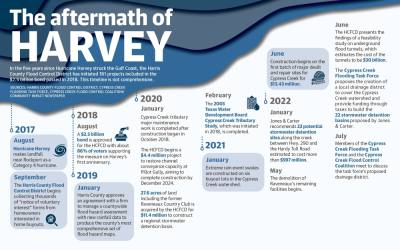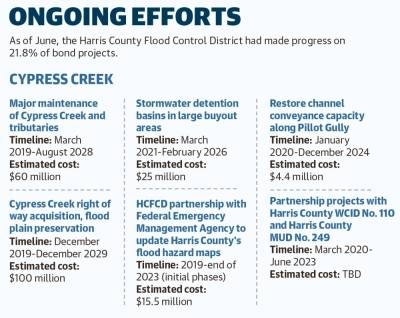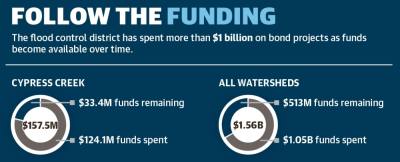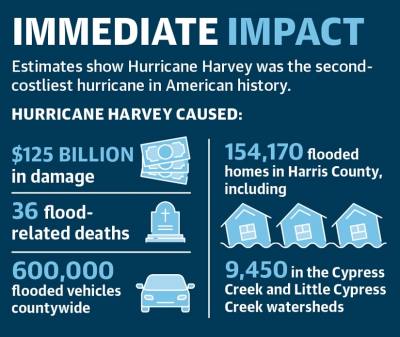As of June, the Harris County Flood Control District’s $2.5 billion bond program, which voters approved in 2018, was 21.8% complete, according to the district’s monthly report. HCFCD Executive Director Tina Petersen said bond projects require time-consuming steps before construction begins, such as feasibility studies, preliminary engineering and design.
“Where we’ve been focused over the last several years is more on what happens inside the district, ... but as we move further into the bond program, more and more of these projects that we’ve been studying and designing are going to happen,” Petersen said.
Flood mitigation is underway along Cypress Creek with more planned as funding becomes available. To supplement the $2.5 billion in bond funding—which becomes available to the district over time—the HCFCD anticipated receiving an additional $2.5 billion from grants and local partnerships. But in May 2021, the Texas General Land Office excluded Harris County from an expected $1 billion in federal funding, leaving the district with a funding gap.
As county flood projects continue, local organization the Cypress Creek Flooding Task Force is trying to speed up the process by creating a drainage district across the Cypress Creek watershed. If approved by the Texas Legislature in 2023 and by voters next November, the district would use property taxes and government funding to help fund the construction of 22 stormwater detention basins recommended for the watershed.
“About 10% of ... [the] Harris County [population] is in the Cypress Creek watershed,” task force Project Chair Calvin Cobb said. “If you can get all of them involved in some kind of modest tax rate, then you can generate enough money to help with the build-out of these detention sites.”
Making progress
One of the first projects executed from the 2018 bond was an update of a 2003 regional drainage plan for Cypress Creek. Jim Robertson, who serves on the board of the Cypress Creek Flood Control Coalition, said the local organization advocated for this updated study to reflect the present needs of the community.
The new study was released in early 2020 and recommended about 8.6 billion gallons of stormwater detention be added to the Cypress Creek watershed.
Robertson said funding for these efforts was not necessarily included in the bond since the updated study came later, but he was pleased to see $291 million of the bond set aside for Cypress Creek.
“Our view is that Cypress Creek has been underfunded through the decades, ... and Cypress Creek did get more funding in the bond issue than historically what we’ve seen,” he said.
HCFCD flood mitigation projects underway in the Spring area along Cypress Creek include a $4.4 million project launched in 2020 to restore channel capacity along Pillot Gully, which is expected to be completed by December 2024. Maintenance efforts along Cypress Creek and its tributaries as well as right of way acquisition and flood plain preservation projects are also ongoing.
In May, the HCFCD began demolition at the site of the former Raveneaux Country Club. The HCFCD acquired the property along with 27.6 acres of land for $11.4 million in January 2020 to construct a stormwater detention basin. However, negotiations with the Cypress Forest Public Utility District, which owns the remaining 206 acres of land, stalled in December.
Meanwhile, a Cypress Creek study released in January by engineering firm Jones & Carter recommended 22 stormwater detention basins be added to the watershed. The projects are expected to cost $597.1 million over the next several years, and officials are working to identify funding sources.
The bond also allocated $20 million for a study to determine the feasibility of constructing underground tunnels countywide to move stormwater from flood centers to a larger body of water. The HCFCD completed Phase 2 of the study in June and estimated a system of eight tunnels—which would follow Harris County waterways, including Cypress Creek—would cost $30 billion.
Innovative solutions
If approved by the Texas Legislature, the Cypress Creek Flooding Task Force’s proposed drainage district would be on the ballot for voters in November 2023. The earliest the district could be submitted as legislation for consideration is in the upcoming 88th Texas Legislature, which will start in January.
In June, task force President Glenn Wilkerson estimated the drainage district’s tax rate would be about $0.10 per $100 valuation.
To get the drainage district on the November 2023 ballot, the Cypress Creek Flooding Task Force brought its proposal to local representatives. State Rep. Sam Harless, R-Spring, said in a July 8 email that he is open to supporting legislation for a district.
“We need a holistic approach, and for the last several months, I have met with stakeholders and groups interested in creating a consolidated and focused effort designed at taking more direct control of flooding efforts for Cypress Creek,” Harless said.
The Cypress Creek Flooding Task Force has also been in talks with other organizations that fight flooding in the Cypress Creek area. Members of the CCFCC met with the task force in late July to discuss the proposed drainage district. The CCFCC board plans to discuss the drainage district further by the end of August, President Emeritus Dick Smith said.
Smith said he is unsure the district would solve all of the Spring area’s flooding problems because more engineering-based solutions may be needed.
Fighting for funding
The HCFCD continues efforts to close the partnership funding gap, Petersen said. As of June 28, the district had secured $1.275 billion in partnership funding with another $754.2 million still needed to fund projects from the 2018 bond.
The U.S. Department of Housing and Urban Development approved a GLO amendment to allocate $750 million to Harris County in March following opposition to the May 2021 decision. David Berry, Harris County administrator and budget officer, said the county is in the negotiation and allocation process for the remaining $750 million.
“We believe that both Harris County and the city of Houston should receive at least $1 billion each for [flood] mitigation,” Berry said in an email.
Another way the district is bridging the funding gap is through the $834.2 million Flood Resilience Trust, which Harris County commissioners approved in June 2021. The trust is designed to fill project needs when partnership funding is unavailable.
Additional funding for the HCFCD was not part of the discussion in a potential county bond issue in November, but Petersen said the combined $5 billion in flood bond and partnership funding should be sufficient to execute the 2018 bond projects despite rising costs associated with inflation.
Rachel Carlton and Danica Lloyd contributed to this report.









